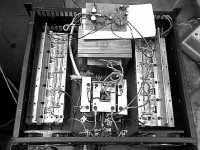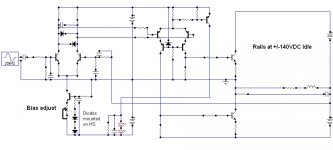The one polarity limitation is there too for power MOSFET and bipolar devices when blocking voltages in excess of 200-300V are required.
Eva said:That's not completely true. The "MOSFET driving BIPOLAR" tale is only a popular way of explaining IGBT behaviour to straight people. An IGBT is a device having a single die and an unique structure which combines the advantages of MOS "channel" effect and bipolar "charge storage" effect. The absence of second breakdown is a consequences of this combination.
The following document shows the internal layout of old and new generation IGBTs and compares them to MOSFET for high voltage switching applications:
http://www.irf.com/technical-info/whitepaper/apec03nptigbt.pdf
Fair enough, but the reference only discusses the devices as
switches, so it really doesn't address any issues in linear use.
I have not tried these, but I have experience with the Toshiba
complementary devices circa 1989. I found that the matching
issues were real and I didn't see performance improvements that
justified the effort or cost.
Several companies rushed products to market, only to backtrack
after a period of time. Reliability appears to have been an issue,
perhaps not the fault of the devices themselves, and of course
the point became moot when the complementary parts were
discontinued.
😎
Upupa Epops said:Yes, it's true, but I mean that we aren't talking about kW amps or switching applications....
😉 ....eg. like this one with 192 x 310W IGBTs for a output of +/-400V @ +/-30A
Attachments
powerbecker said:😉 ....eg. like this one with 192 x 310W IGBTs for a output of +/-400V @ +/-30A
I believe that with that kind of hardware we could build a decent
IGBT amp...
😎
Upupa Epops said:Yes, it's true, but I mean that we aren't talking about kW amps or switching applications....
For lower power linear amplifiers we already have a wide choice of popular low cost high performance transistors. MOSFET devices excel when they are not required to block more than 200 volts, and audio bipolars have a nicely flat current gain as opposed to the square law of MOS devices. However, there is really little stuff for "KW" amplifiers.
With series connections on balanced circuits with 200V devices
we can approach +/- 400V peaks, which is:
mumble..mumble...
10 KW rms into 8
20 KW rms into 4
40 KW rms into 2
Of course your real mileage will be less than that.
😎
we can approach +/- 400V peaks, which is:
mumble..mumble...
10 KW rms into 8
20 KW rms into 4
40 KW rms into 2
Of course your real mileage will be less than that.
😎
Nelson Pass said:With series connections on balanced circuits with 200V devices
we can approach +/- 400V peaks, which is:
mumble..mumble...
10 KW rms into 8
20 KW rms into 4
40 KW rms into 2
Of course your real mileage will be less than that.
😎
Can't plug that amp into a regular outlet. Standard 20 amp household receptacle only provides 2.4KVA @ 120 VAC. What kind of power supply do you use for an amp that big? A pole pig (distribution transformer)?
Are the LabGruppen, Camco, Powersoft amps using these in thier topology to get thier crazy output power?
powerbecker what is this module used for ????
is it in your lounge room hifi setup 😉 ?? or an ac motor controller???
-Dan
is it in your lounge room hifi setup 😉 ?? or an ac motor controller???
-Dan
I have been built
an Elector IGBT amp
by Giesberts...
That one from the first page SCH
while ago (1998?)
that was two mono blocks in same chasis...
I must say that was amp to remeber
realy...
etremly fast sound
excelent dumping factor
and operation i class A to about 2.5W
with 400mA cuescient current
the amp shows no Sandy sound against MOSFET amps
sound sometimes could be compared with germanium amps...
IGBT devices was not coupled
but all other BC550C/BC560C was...
I remember that I get better values then at the specimen measured,
build by Elector
an Elector IGBT amp
by Giesberts...
That one from the first page SCH
while ago (1998?)
that was two mono blocks in same chasis...
I must say that was amp to remeber
realy...
etremly fast sound
excelent dumping factor
and operation i class A to about 2.5W
with 400mA cuescient current
the amp shows no Sandy sound against MOSFET amps
sound sometimes could be compared with germanium amps...
IGBT devices was not coupled
but all other BC550C/BC560C was...
I remember that I get better values then at the specimen measured,
build by Elector
danieljw said:powerbecker what is this module used for ????
is it in your lounge room hifi setup 😉 ?? or an ac motor controller???
-Dan
Dan,
it´s for my piezo hearing aid 😀
No, it´s for test and research, for a motor controller one don´t need 150kHz bandwidth.
Heinz!
Eva said:
However, there is really little stuff for "KW" amplifiers.
Evita, "There is a huge stuff for KW level amplifiers if built using
All N-channel Output Stage"😉
IGBT
Threshold made 2 series of amplifiers using IGBTs, the T series and Forte.
Personally, I think they are still some of the best sounding amps out there and that IGBTs are one of the best sounding output devices. I will be comparing my Threshold T400 to a X150 shortly. The T400 is ready for a recap-90000+ hours, so it may not be a fair comparison but speaks volumes as to their reliability in a power amp application.
Class A operation is not a problem with N channel only devices. I'm not sure there are currently any suitable devices in production as most of the newer parts have an integrated snubber diode for motor controller applications which again speaks to reliability.
Threshold made 2 series of amplifiers using IGBTs, the T series and Forte.
Personally, I think they are still some of the best sounding amps out there and that IGBTs are one of the best sounding output devices. I will be comparing my Threshold T400 to a X150 shortly. The T400 is ready for a recap-90000+ hours, so it may not be a fair comparison but speaks volumes as to their reliability in a power amp application.
Class A operation is not a problem with N channel only devices. I'm not sure there are currently any suitable devices in production as most of the newer parts have an integrated snubber diode for motor controller applications which again speaks to reliability.
I Believe My Ears... Forget Theory
Sorry to revive an old thread...
I own several old Forte Model 4's and I can say with no reservations that they continue to compete with today's best offerings. The ONLY caveat I would add is that they're a bit week in the lowest octaves. However, they're very clean and detailed from midbass through the highest octaves. They are finely detailed without a HINT of harshness. I'm told that the updates available from V.A.R. further enhance these little amps' performance, particularly in the bottom end.
Regarding bass weakness: I use larger amps for my subs and reserve the sweet Class A 50 WPC for the frequency range in which these babies excell.
I believe my ears rather than formulae or theory. I frankly don't care what output devices they use. My ears are the most important/trusted measuring devices I could ever own.
Sorry to revive an old thread...
I own several old Forte Model 4's and I can say with no reservations that they continue to compete with today's best offerings. The ONLY caveat I would add is that they're a bit week in the lowest octaves. However, they're very clean and detailed from midbass through the highest octaves. They are finely detailed without a HINT of harshness. I'm told that the updates available from V.A.R. further enhance these little amps' performance, particularly in the bottom end.
Regarding bass weakness: I use larger amps for my subs and reserve the sweet Class A 50 WPC for the frequency range in which these babies excell.
I believe my ears rather than formulae or theory. I frankly don't care what output devices they use. My ears are the most important/trusted measuring devices I could ever own.
Work horse .What is the schematic like I would love to see it !
the photo of your amp looks good,very good
regards Trev
the photo of your amp looks good,very good
regards Trev
- Home
- Amplifiers
- Solid State
- IGBT amplifiers


